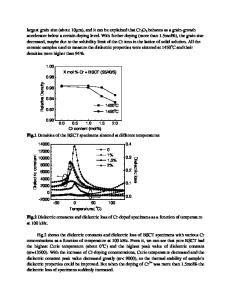Dielectric relaxation and microwave dielectric properties of Bi 2 O 3 -ZnO-Ta 2 O 5 ceramics
- PDF / 115,928 Bytes
- 5 Pages / 612 x 792 pts (letter) Page_size
- 58 Downloads / 394 Views
e permittivity of two primary phases within the Bi2O3–ZnO–Ta2O5 system was measured from 100 Hz to approximately 8.7 GHz. A cubic pyrochlore (Bi3/2Zn1/2)(Zn1/2Ta3/2)O7 phase (␣ phase) exhibited a dielectric constant of 71 at low frequency which decreased to 64 at approximately 10 GHz. A lower symmetry zirconolite Bi2(Zn1/3Ta2/3)2O7 phase ( phase) was also measured and had a frequency independent dielectric constant of 60. The temperature dependence of the capacitance (C), measured from −55 to 120 °C, was 78 ppm/°C for the  phase and nonlinear for the ␣ phase having no unique slope. The primary difference in dielectric properties between these two phases was a low-temperature relaxation of the ␣ phase, which is modeled as a basic Debye-type relaxation.
I. INTRODUCTION
Interest in miniaturized filters for wireless applications has prompted the development of new dielectric materials with high dielectric constant (K), moderate quality factor (Q), and low-temperature coefficient of capacitance (C).1,2 Historically, microwave dielectric materials development activities have focused on high-Q materials (Q > 10,000); however, recent device manufacturers emphasize process compatibility with low resistivity metals and allow for lower Q dielectrics (Q ≈ 200). This change in materials needs has created several new classes of high-frequency dielectric materials. Ceramics based on the Bi2O3–ZnO–Ta2O5 (BZT) and Bi2O3–ZnO– Nb2O5 (BZN) ternary systems are promising dielectrics because C can be compositionally controlled to a low value. In addition, their low sintering temperatures allow cofiring with silver, which is selected for high conductivity and compatibility with air-fired lowtemperature cofired ceramic processes.3 The pyrochlore material class encompasses a large array of conductor, semiconductor, and dielectric properties.4 The pyrochlore chemical formula is A2B2O7, and the crystal structure can be described as interpenetrating networks of BO6 octahedra and A2O⬘ chains.5 The structure also accommodates a wide range of substituents, which allows dielectric properties to be altered by compositional variation.6 There are two major structural variations in this study: (1) a cubic pyrochlore (␣–BZT) based on the (Bi3/2Zn1/2)(Zn1/2Ta3/2)O7 composition; (2) a lower symmetry zirconolyte phase (–BZT) based on the Bi2(Zn1/3Ta2/3)O7 composition. The relationship between the zirconolyte and pyrochlore structures can be 1502
http://journals.cambridge.org
J. Mater. Res., Vol. 17, No. 6, Jun 2002 Downloaded: 17 Mar 2015
described by sheets of three- and six-member octahedral rings. The distinction between these phases is described by stacking differences in adjoining hexagonal tungsten bronze layers.7 Additional structural features in the pyrochlore phase have been recently explored to correlate dielectric properties with crystal structure. Reitveld refinement of the ␣–BZN structure revealed significant positional disorder for the A-site cations and O⬘ anions to form asymmetric eightfold-coordinated sites.8 The stability range
Data Loading...











